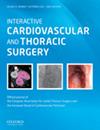Are sequential compression devices routinely necessary following enhanced recovery after thoracic surgery?
IF 1.6
4区 医学
Q3 CARDIAC & CARDIOVASCULAR SYSTEMS
引用次数: 0
Abstract
Abstract OBJECTIVES The prominence of “enhanced recovery after surgery” (ERAS) protocols being adopted in thoracic surgery requires a re-evaluation of mechanical venous thromboembolism (VTE) prophylaxis guidelines. The goal of this study was to assess the role of sequential compression devices (SCD) in the prevention of VTEs such as deep vein thrombosis and pulmonary embolism (PE) in thoracic surgical patients. METHODS We identified 200 patients who underwent elective oncological thoracic surgery between December 2018 and December 2020 in 2 cohorts—1 with SCDs and 1 without (i.e. non-SCD). All patients followed a standardized enhanced recovery after surgery (ERAS) protocol. The quality of care provided by SCDs was evaluated by the incidence and severity of postoperative and follow-up VTEs. Cohorts were compared by the Caprini score (CS) and the Charlson Comorbidity Index (CCI) with a two one-sided t-test analysis. Secondary outcomes include perioperative characteristics and follow-up data. RESULTS Only 2 patients within the SCD group developed a PE with average CS and CCI metrics, both after hospital discharge and treated with anticoagulants, raising concern over the prophylactic nature of SCDs. The CS (6.9 ± 1.3 and 6.9 ± 1.5; P = 0.96) and the CCI (3.8 ± 2.0 and 4.1 ± 2.6; P = 0.33) for non-SCD and SCD, respectively, did not differ. The two one-sided t-test analysis for CS (P < 0.001) and CCI (P < 0.001) demonstrated equivalence. CONCLUSIONS Although larger studies are required to confirm these results, routine SCD use may not be required when implementing ERAS protocols because clinically significant VTE rates were minimal.在胸外科术后增强恢复后,是否常规需要序贯压迫装置?
摘要目的“术后增强恢复”(ERAS)方案在胸外科手术中的突出地位要求对机械性静脉血栓栓塞(VTE)预防指南进行重新评估。本研究的目的是评估序贯压迫装置(SCD)在预防胸外科患者深静脉血栓形成和肺栓塞(PE)等静脉血栓栓塞(vte)中的作用。方法:在2018年12月至2020年12月期间,我们将200名接受选择性肿瘤胸外科手术的患者分为2组,1组患有scd, 1组没有(即非scd)。所有患者都遵循标准化的术后增强恢复(ERAS)方案。通过术后和随访静脉血栓栓塞的发生率和严重程度来评估scd提供的护理质量。采用双单侧t检验比较capryini评分(CS)和Charlson共病指数(CCI)。次要结局包括围手术期特征和随访数据。结果:SCD组中仅有2例患者在出院后和接受抗凝治疗后发生了CS和CCI指标平均的PE,这引起了人们对SCD预防性质的关注。CS分别为6.9±1.3和6.9±1.5;P = 0.96), CCI分别为3.8±2.0和4.1±2.6;P = 0.33),非SCD和SCD的差异无统计学意义。CS (P < 0.001)和CCI (P < 0.001)的两个单侧t检验分析证明了等效性。结论:虽然需要更大规模的研究来证实这些结果,但在实施ERAS方案时可能不需要常规SCD,因为临床显著的VTE发生率很小。
本文章由计算机程序翻译,如有差异,请以英文原文为准。
求助全文
约1分钟内获得全文
求助全文
来源期刊

Interactive cardiovascular and thoracic surgery
CARDIAC & CARDIOVASCULAR SYSTEMS-
CiteScore
3.30
自引率
0.00%
发文量
292
审稿时长
2-4 weeks
期刊介绍:
Interactive CardioVascular and Thoracic Surgery (ICVTS) publishes scientific contributions in the field of cardiovascular and thoracic surgery, covering all aspects of surgery of the heart, vessels and the chest. The journal publishes a range of article types including: Best Evidence Topics; Brief Communications; Case Reports; Original Articles; State-of-the-Art; Work in Progress Report.
 求助内容:
求助内容: 应助结果提醒方式:
应助结果提醒方式:


